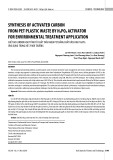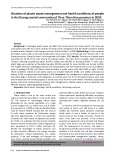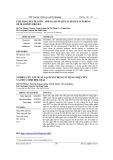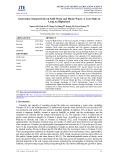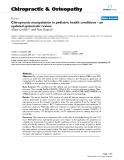
108
Journal of Medicine and Pharmacy, Volume 12, No.07/2022
Situation of plastic waste management and health conditions of people
in Hai Duong coastal community of Thua Thien Hue province in 2020
Ton That Canh Tri1*, Nguyen Van Thanh Nhan3, Nguyen Le Hanh Nguyen4,
Hoang Thi Binh Minh5,6,7, Nguyen Dac Hoang Long5, DangThi Anh Thu1,2
(1) Faculty of Public Health, University of Medicine and Pharmacy, Hue University
(2) Institute for Community Health Research, University of Medicine and Pharmacy, Hue University
(3) Occupational Health Center, Buu Dien Hospital
(4) Centers for Disease Control and Prevention Ho Chi Minh city
(5) Mientrung Institute for Scientific Research
(6) Vietnam National Museum of Nature
(7) Vietnam Academy of Science and Technology (VAST)
Abstract
Background: Unmanaged plastic waste will affect the environment and human health. The study was
conducted to describe the current situation of plastic waste management and the health conditions related
to plastic waste of people in Hai Duong commune, Central Vietnam, in 2020. Methodology: A cross-sectional
descriptive study using a structured questionnaire was carried out on 291 people over 18 years old in Hai
Duong commune, Huong Tra town, from September to October, 2020. Results: The amount of plastic waste
accounted for 16.5% of the total volume of collected waste. The main forms of plastic waste treatment
included collecting at gathering places (87.3%), selling scrap (60.8%), or burning (19.9%). In most cases,
plastic bags were collected at the gathering place (90.4%), washed for reuse (45.4%), and burned (14.8%).
The notable weakness of garbage collection and transportation was that residents did not sort out different
types of garbage (29.6%), and littered indiscriminately in public places with little traffic at night (11.3%).
Health conditions related to over-plastic waste use included headache (9.6%), rash (4.8%), cardiovascular
disease (5.2%), and gastrointestinal disease (3.4%). Conclusion: The management of plastic waste in general
and plastic bags in particular is still inadequate. It could be seen that if a lot of plastic products were used
and the waste was not handled properly, it would cause much harm to human health. Therefore, appropriate
policies need to be implemented to improve local management of plastic waste as well as awareness and
effective practices regarding garbage disposal.
Keywords: Plastic waste, nylon bags, health conditions, Hai Duong commune.
Corresponding author: Ton That Canh Tri, email: ttctri@huemed-univ.edu.vn
Recieved: 14/11/2022; Accepted: 8/12/2022; Published: 30/12/2022
1. INTRODUCTION
Plastic waste is one of the most serious and
urgent environmental problems in the world today
[1]. The amount of mismanaged plastic waste
generated by the coastal population of a single
country ranges from 1.1 million tons to 8.8 million
tons per year [2]. In 2020, a study by the World Wide
Fund for Nature (WWF) showed that the amount
of solid waste produced by Vietnamese people
was 0.94 kg/person/day, in which the proportion
of plastic and nylon waste components accounted
for 17.8%. It is estimated that the amount of plastic
waste lost to the environment is about 5kg/person/
year, equivalent to 0.3-0.7 million tons/year [3].
Besides the advantages of plastic products such
as high economic efficiency, less energy required
for production, medical applications, etc., plastic
products, if not well managed, will become the
main factor causing environmental pollution and
adversely affect human health such as eye irritation,
vision impairment, breathing difficulties, respiratory
problems, cancer, skin diseases, effects on fertility,
cardiovascular disease, digestive diseases [4], [5],
[6].
In Vietnam, 67% of households do not separate
their waste at home, and 11% dump it in public
landfills [3]. Domestic waste pollution, especially
plastic waste, is also a matter of concern in the
coastal area of Hai Duong commune, Huong Tra
town, Thua Thien Hue province. In the summer,
especially on weekends, many domestic and foreign
tourists come here to visit and have fun. However,
with the development of tourism, this beach is
facing serious pollution due to waste. Environmental
pollution in the locality has not been thoroughly
resolved due to a lack of data to assess the situation
and unreasonable management practices. Hence,
we conducted a research to evaluate the current
DOI: 10.34071/jmp.2022.7.15





